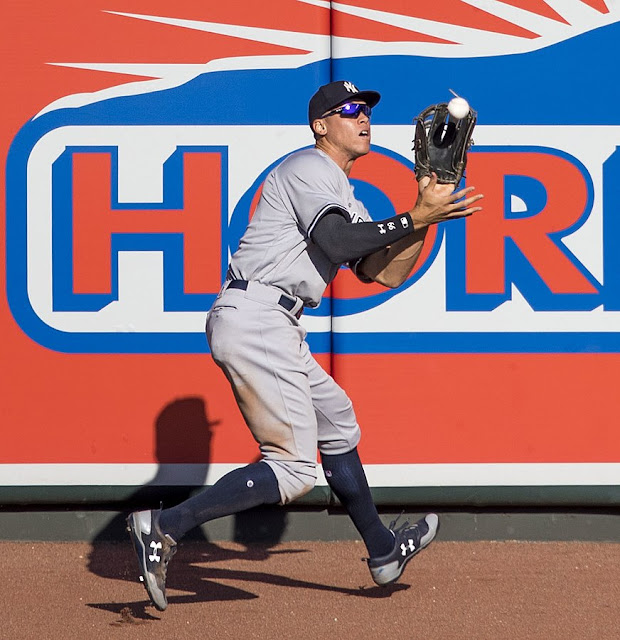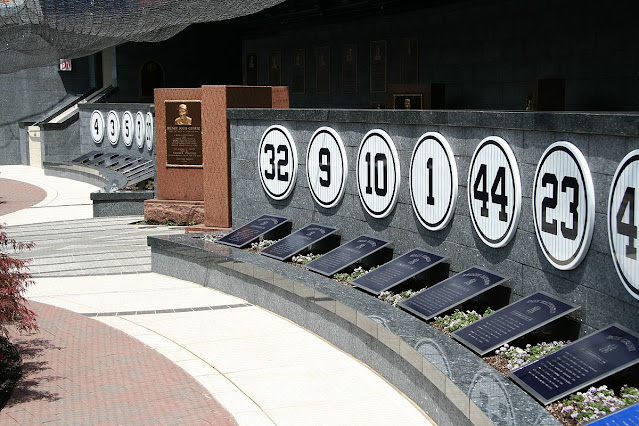In his brief career thus far, Aaron Judge has mostly been known for two things: hitting massive home runs and getting hurt. This year has been representative of that reputation. Judge missed time this spring due to a rib injury that also resulted in a collapsed lung. He benefited from the delayed start to the season and recovered in time for Opening Day where he got right to work. In just 68 plate appearances he crushed nine home runs before a lingering calf injury sidelined him again.
But we're not here to talk about home runs and nagging injuries when it comes to Aaron Judge. We're here to talk about the fine work he has done in right field during his career. While I'm certainly not the first person to bring up this under-appreciated aspect to his game, it's worth a closer look nonetheless.
It's no secret that Judge is a big, strong athlete with tons of raw talent, but his skill as a fielder is undeniable. No matter how you measure his value in right field, he stacks up favorably to the best of the best in the major leagues. His fielding numbers can convince any baseball fan from the most hardened traditionalists to the most progressive-minded analysts out there that his value to the Yankees goes well beyond the long ball.
For the Traditionalists
There are some among this crowd who have no use for numbers at all. So let's start by saying that Aaron Judge passes the eye test when patrolling right field. While his 6-foot-7, nearly 300-pound frame may prevent any comparisons to the likes of the graceful Roberto Clemente, he's still a delight to watch in the field. He rarely takes a bad angle to the ball, has a cannon for an arm, and has one of the surest gloves in Major League Baseball. If one were to assess Judge's fielding ability based on observation alone, there is no glaring weakness to speak of.
Aaron Judge's glove is as close as you get to a sure thing in right field.
Keith Allison/Wikimedia Commons
Now let's ease into some fielding numbers that even a traditionalist can get behind. For his career, Judge has a sparkling .987 fielding percentage, which is better than the average right fielder over that time. In fact, that number has been steadily improving as he has not made an error in the field since 2018.
We've already made mention of his strong arm, but Judge's assist numbers back up that claim. In the past two full seasons, and despite missing significant time to injury, he has ranked third among right fielders with nine assists in 2018 and seven in 2019. Not only can he unleash the ball with fury, but he can be accurate as well.
Last but not least, Judge's range factor ((putouts + assists) / games played) indicates that he can cover a lot of ground in right field even as a lumbering giant. Over the past three seasons his range factor values have ranked no worse than fifth among major league right fielders. At this point we've likely pushed the limits for metrics that traditionalists are willing to accept, so let's move on to some of the fancy, advanced stuff.
For the Box Score Snipers
Have you ever spent time poring over box scores or game recaps in the newspaper so you can imagine what kind of dazzling plays might have been made during a game? If so, then Total Zone is the fielding statistic for you. Total Zone uses play-by-play data available for game events to assess a player's performance in the field versus the league average. Like most advanced metrics these days, Total Zone is expressed in terms of the number of runs above or below average a player is.
All players get rated based on their ability to get to a batted ball and make a play on it. For outfielders, there's a component added for their arm. That is, their ability to make assists from the outfield and/or prevent baserunners from advancing. In either case, the Total Zone results for Aaron Judge put him in a very positive light.
For his career, Judge is rated as 37 runs above average when it comes to his ability to field the ball, and is another 12 runs above average thanks to his deadly arm. In 2017, his 20 total runs above average ranked third among all major league outfielders, regardless of position, with only Byron Buxton and Mookie Betts comparing favorably. Two years later, he again was rated as 20 runs above average per Total Zone and this time that number was tops among all outfielders.
Of course, this just corroborates what we've already established by using simple observation and some very basic statistics. Still, it's encouraging that as we're getting more advanced with fielding metrics, Judge is looking better and better. Let's take it a step further and see what happens.
For the Video Room Junkies
There are two widely accepted versions of the WAR statistic these days, Baseball Reference and Fangraphs, and those two versions use very similar defensive metrics as components in their calculations, Defensive Runs Saved and UZR, respectively. Those metrics are so similar, in fact, that they are calculated using data from the same company. At Baseball Info Solutions, they review video tape of every play made in the field and cut that field up into a grid so that performance can be assessed as scientifically as possible. Using probabilistic models, they then assign run values, positive or negative, to each play to determine a player's overall contribution with the glove.
The main difference between the two is in how they segment certain batted ball types into different buckets. While DRS is more granular in that respect than UZR, for most intents and purposes, the difference in results is near negligible.
So what do these fancy metrics say about our man, Aaron Judge? In short, they say that he may be even more spectacular in the field than we initially thought. In long, let's take a deeper dive into these numbers and see what they tell us about Judge.
Each of these metrics has three components to it for outfielders that are similar enough that we can reasonably compare them. They are the player's throwing ability (Arm), the player's ability to get to a batted ball (Range), and the player's ability to field the ball cleanly when they get to it (Glove). According to both systems, Aaron Judge has no holes as a fielder. That is, for each component his value is at least above average, and in some cases extremely so.
| Aaron Judge - 2017 thru 2020 |
| DRS | UZR |
| Range | 26 | 14.4 |
| Glove | 8 | 1.1 |
| Arm | 14 | 14.2 |
| Total | 48 | 29.7 |
With a powerful, accurate arm, Judge is a complete fielder.
Keith Allison/Wikimedia Commons
So it's clear that Judge is well above average according to these metrics, but where does he fall in the overall MLB landscape with those values given above? Well, he's right near the top of the heap. And that's among all major leaguers, not just outfielders. The below table lists the consensus top 10 fielders in the majors from 2017 through 2020 according to DRS and UZR.
| | DRS | UZR |
| Player | Position | Value | Rank | Value | Rank |
| Mookie Betts | RF | 72 | 3 | 52.9 | 1 |
| Matt Chapman | 3B | 82 | 1 | 39.8 | 3 |
| Andrelton Simmons | SS | 74 | 2 | 47.7 | 2 |
| Kevin Kiermaier | CF | 55 | 5 | 25.9 | 8 |
| Nolan Arenado | 3B | 50 | 6 | 29.5 | 5 |
| Aaron Judge | RF | 48 | 7 | 29.7 | 4 |
| Lorenzo Cain | CF | 45 | 8 | 19.6 | 18 |
| Byron Buxton | CF | 40 | 9 | 23.9 | 11 |
| Nick Ahmed | SS | 56 | 4 | 7.2 | 71 |
| Francisco Lindor | SS | 31 | 16 | 27.6 | 7 |
The table speaks for itself, but I'll add to it just a bit here. No matter how you slice it, Aaron Judge isn't a decent or pretty good, or even really good fielder. He's an elite fielder who provides significant value with the glove when he plays. Keep this in mind the next time he's slumping at the plate or experiences a home run drought. He clearly maximizes his athletic potential by covering a ton of ground in the field despite lacking great speed, and makes big plays when he gets to the ball. Maybe it's that kind of effort that results in injuries with some frequency for Judge, but it's the kind of effort you'd expect from a true superstar.


.jpg)


Comments
Post a Comment